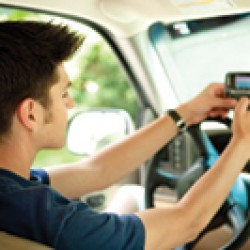Driver’s Education
A virtual behind-the-wheel experience tracks behavior on the road.

Sensors inside the UW’s Driving Simulation Laboratory — a modified Ford Fusion and a large wraparound screen — allow researchers to measure braking reaction time and track where a driver’s eyes wander when they should be on the road, including to a cell phone. Photo: Jeff Miller.
Nobody likes a backseat driver, but researchers at one campus lab have good reason to scrutinize your driving performance — they’re leading the way to safer vehicles and roadways.
In the UW’s Driving Simulation Laboratory, located in the Mechanical Engineering building, research participants navigate fictitious freeways, busy intersections, and downtown traffic while cameras and other sensors inside the simulator collect data, measuring braking reaction time and tracking where a driver’s eyes wander when they should be on the road.
Climbing into the modified Ford Fusion is an immersion experience featuring 270 degrees of visual simulation, thanks to a twenty-four-foot wraparound screen, and movement down to one degree in any direction. This allows the car’s body to react realistically to acceleration, braking, and turns, further enhancing the pseudo-vehicle’s believability.
David Noyce ’84, MS’95, the civil and environmental engineering professor who heads much of the lab’s research, says the tool will allow his team to run tests on in-vehicle technology and notoriously dangerous sections of roadway without putting anyone at risk.
A partnership with the Wisconsin Department of Transportation will implement solutions identified by Noyce and his colleagues, directly affecting the way Wisconsinites drive. Other research will explore driver distractions, such as cell-phone use, and test designs for driver-friendly orthopedic boots, along with future projects headed by undergraduates.
Published in the Winter 2011 issue



Comments
No comments posted yet.